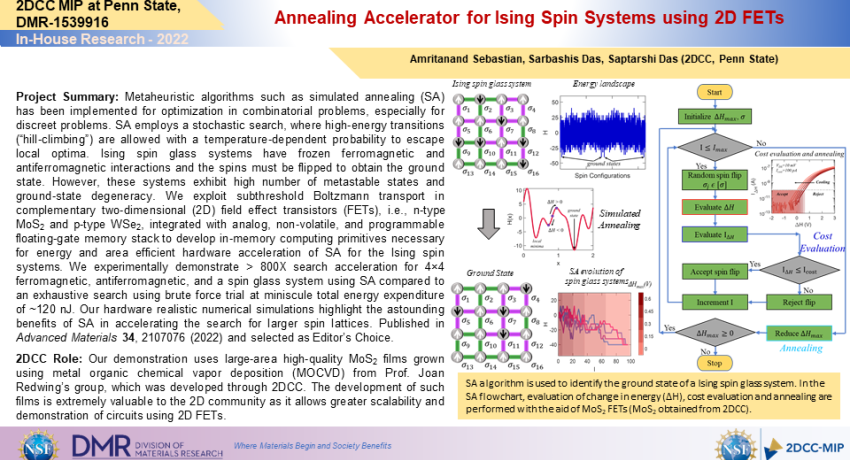Project Summary: Metaheuristic algorithms such as simulated annealing (SA) has been implemented for optimization in combinatorial problems, especially for discreet problems. SA employs a stochastic search, where high-energy transitions (“hill-climbing”) are allowed with a temperature-dependent probability to escape local optima. Ising spin glass systems have frozen ferromagnetic and antiferromagnetic interactions and the spins must be flipped to obtain the ground state. However, these systems exhibit high number of metastable states and ground-state degeneracy. We exploit subthreshold Boltzmann transport in complementary two-dimensional (2D) field effect transistors (FETs), i.e., n-type MoS2 and p-type WSe2, integrated with analog, non-volatile, and programmable floating-gate memory stack to develop in-memory computing primitives necessary for energy and area efficient hardware acceleration of SA for the Ising spin systems. We experimentally demonstrate > 800X search acceleration for 4×4 ferromagnetic, antiferromagnetic, and a spin glass system using SA compared to an exhaustive search using brute force trial at miniscule total energy expenditure of ~120 nJ. Our hardware realistic numerical simulations highlight the astounding benefits of SA in accelerating the search for larger spin lattices. Published in Advanced Materials 34, 2107076 (2022) and selected as Editor’s Choice.
2DCC Role: Our demonstration uses large-area high-quality MoS2 films grown using metal organic chemical vapor deposition (MOCVD) from Prof. Joan Redwing’s group, which was developed through 2DCC. The development of such films is extremely valuable to the 2D community as it allows greater scalability and demonstration of circuits using 2D FETs.
What Has Been Achieved: Demonstration of SA to find the ground states of an Ising spin glass system. We use 2D material-based computing primitives to implement SA in an area- and energy efficient manner. Further, we use in-memory computing to increase the efficiency of this implementation.
Importance of the Achievement: The development of novel hardware for SA would aid the general field of combinatorial optimization, where finding the optimal solution is extremely time/energy/area consuming without the use of such algorithms and hardware. Hence this could be used to optimize various tasks such as scheduling of transportation, supply chain logistics, and circuit design.
Unique Feature(s) of the MIP that Enabled this Achievement: Dr. Joan Redwing’s group through 2DCC developed high-quality MoS2 films using MOCVD, which was crucial to our hardware development.
(If Applicable) Publication: Sebastian, A., Das, S., Das, S., An Annealing Accelerator for Ising Spin Systems Based on In-Memory Complementary 2D FETs. Adv. Mater. 2022, 34, 2107076. https://doi.org/10.1002/adma.202107076
The work was supported by Army Research Office (ARO) through Contract Number W911NF1920338. Support for MoS2 growth and characterization at Penn State was provided by the National Science Foundation (NSF) through the Pennsylvania State University 2D Crystal Consortium–Materials Innovation Platform (2DCC-MIP) under NSF cooperative agreement DMR-1539916.
